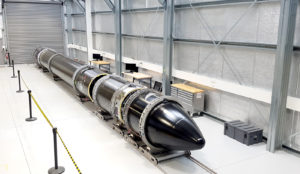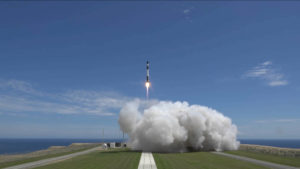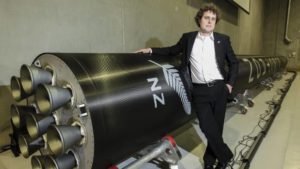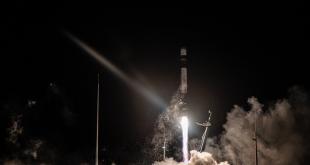
On 23 June 2018, Rocket Lab’s launch window for the ‘It’s Business Time’ mission will open. During this 14-day window, the company will launch its groundbreaking Electron rocket and will transform access to space for the small satellite market.
The Electron will build up its launch frequency over the coming months and will eventually fly every 72 hours. This much needed launch capacity will help to alleviate the launch bottleneck that is currently holding back the smallsat market.
The Electron is a carbon composite rocket that utilises 3D printed ‘Rutherford’ engines and leaves no trace of itself in space once its payloads have been deployed. The ingenious system is the brainchild of Rocket Lab’s CEO, Peter Beck. Helen Jameson, Editor-in-Chief, SpaceWatch.Global had the privilege of speaking with him to delve down deeper into the Rocket Lab story.
Tell us about the genesis of Rocket Lab. What was it that set you off on this journey in the first place?
 I started the company back in 2006 and it came out of a trip to the United States. I had been corresponding with a lot of people over there and I had been building rockets ever since I was at high school. It reached a point where there were two things that were really obvious. One, I felt that small spacecraft were going to play a big part in the industry going forward.
I started the company back in 2006 and it came out of a trip to the United States. I had been corresponding with a lot of people over there and I had been building rockets ever since I was at high school. It reached a point where there were two things that were really obvious. One, I felt that small spacecraft were going to play a big part in the industry going forward.
If you look at what a spacecraft is, it’s basically a bunch of electronics, a bunch of solar panels and batteries – to which Moore’s Law has been applying itself to for a long period of time. It was very obvious that spacecraft were going to get smaller. Of course, if you have small spacecraft it really doesn’t make sense to send a large launch vehicle up into space. That bore out, and from 2007 to 2009 it was really about building credibility and capability in the company. In 2009, when we launched our first rocket, we became the first private company in the southern hemisphere to reach space. And then, from 2009 to 2013, we cut ourselves a bit of a reputation for doing this really hard stuff that no one else would touch or thought was possible. We were kind of like a mini Skunk Works and we did a lot of work with DARPA, Lockheed Martin, Rocketdyne and those kinds of companies.
In 2013, I figured that we had done enough with the industry and we’d built the right team so we decided to go out and raise the capital to build a small launch vehicle. We did that and we raised out of tier 1 Silicon Valley venture capital and spent the next four years developing the Electron launch vehicle. We have now completed the test flight programme and in about 14 days we will launch the first fully commercial mission. However, the last test flight we did have two paying customers and we deployed four operational satellites into orbit so you could really say that was a commercial launch.
It’s not just putting something into orbit. We were within 1km at perigee and 3km at apogee and .09 degree of inclination of our orbital parameters. These are numbers that are usually reserved for the most exquisite government launch vehicles and we hit them all. It wasn’t just the fact that we made it to orbit. This was a precision insertion.
You are a U.S. company with a New Zealand subsidiary and you have established your launch complex on the Mahia Peninsula. Tell us about the reasons why you selected that site.

When we initially started the programme, we went to all the launch sites in America and every single one is a government-owned facility. We said that we needed to launch very frequently here and we asked how we could operate out of these various facilities. They were all very supportive and agreed with that ethos. However, the reality was that it’s one of the few things in America that doesn’t scale well. It doesn’t scale well because of all the air traffic and all the shipping movements that are over the continent.
When you launch a rocket, you have to close down a 200km area of airspace and shipping lanes, meaning that you have to divert and delay flights and it’s a big deal. At Cape Canaveral today, where SpaceX launch from, they are at absolute capacity. It is bursting. If we had set up in Cape Canaveral, we would be completely throttled by launch frequency. What we are really trying to do here is open up a domain – to open space up for the small satellite industry and for new companies to develop new technology and also for established companies to simply get their infrastructure on orbit. Frequency is absolutely key and you just can’t get the launch frequency out of the U.S.
We hunted around and the ideal launch site was a small island nation in the middle of nowhere and that’s what New Zealand affords us. It took a lot of work. It took a lot of treaties, entire regulatory frameworks to be passed into law, state agencies created – a lot of work! But from that little launch site, we have more launch availability as a private company that America does as a country. It was worth the effort.
The smallsat launch situation is poor from the operator perspective, with such a lack of dedicated and short notice launches. What response are you getting from the smallsat community as you move towards commercial operations later this month?

The reality is that we are the only small launch vehicle in operation. Right now, there are two private companies on the planet putting small spacecraft in orbit. There is SpaceX and Rocket Lab. We have demonstrated that we can place payloads in orbit incredibly accurately. Obviously, the customer response has been fantastic. One of the interesting things about the industry right now is that there is something like 40 different companies building small launch vehicles, or trying to build them. To me, standing back, it’s just crazy to watch. We see all these different companies going out there and pitching their wares and I stand there with my mouth open. You hear statements such as ‘we can launch off the back of a trailer’ and it’s just absolutely crazy. The market recognises that.
We have some slots left in 2019 but we have put more flights on. This year, we will be flying pretty much every month from here on in. We have a factory full of rockets right now so that we can get to one a month this year and then next year we aim for one every two weeks and we’ll just carry on doubling down. We’re building big factories in the U.S. and in New Zealand. We have a three-acre factory in America now so it’s a massive scale-up. It’s great because we feel like we are liberating the smallsat market for the right cost and in the right timeframe. We are also seeing operators develop payloads specially for the Electron. The Electron format has actually triggered a new class of payload because the ride is so smooth and gentle. People are re-defining how they build spacecraft. No longer do they have to be strapped to the side of some giant ICBM, they can have a smooth ride. This is exactly what we wanted to see and it’s hugely exciting to see it happening.
I believe that there are around 50 dedicated smallsat launch vehicles in development at the moment with many slated to launch by 2020. How do you feel about competition in the smallsat launch market?
I think competition is great. Personally, I think the numbers in the market are somewhat overinflated. We have a very good handle on the market size. I think the market will be big enough to support two providers – maybe a third. However, when we see folks saying they are going to launch 200 rockets a year, we don’t see that in the market. The space industry is a funny one. You can promise something and, for many years, never deliver on that promise. It’s a funny kind of industry. Rocket Lab has always been of the mind that we will keep our head down and keep quiet and let our results speak for themselves rather than try to enter into a whole load of hype. There is certainly some crazy stuff out there and it’s easy to sell a PowerPoint for a few years but let’s see some real technology and real hardware. Ultimately, the proof is getting to the pad.
You very recently opened the launch window for the ‘It’s Business Time’ mission which was postponed. Has the issue with the motor controller been resolved? How are you and the team feeling in the run up to your first commercial launch?
We are very conservative folks over here. During the wet dress rehearsal we saw some unusual behaviour in one of the motor controllers and, let’s face it, that’s what dress rehearsals are for. We will never fly unless we understand the root cause and it turned out to be a very simple corrective process. It wasn’t even a component, but it was a very tortuous path to find out what the root cause actually was. Until it was resolved we would never take things forward and try to fly, especially with a customer’s payload. It took us a good month to determine the root cause and rectify the process. Now, the vehicle is on the pad and we will get it away safely.
You have also picked up some more payloads for the launch. Can you tell us a bit more about how that happened? This surely illustrates that flexibility that Rocket Lab can offer.
Yes. Exactly. We have quite a backlog of customers and you need the stars to align. The customer has got to be ready and you have to have the paperwork and licensing in order. During that downtime, our sales and customer team worked together with some customers and used those few weeks to work through the licensing process and get the payloads not only manifested but integrated and ready to fly. You would normally measure that process in months, not in weeks. It’s great testament to the team that we can truly demonstrate that responsiveness.
What is the Electron’s launch manifest looking like over the coming months?

This year is totally full. We have no space at all. 2019 is largely full but there are some opportunities we have created simply because we needed to try to create some spaces for new customers. Into 2020, we are doubling down again and it’s pretty busy. It’s not surprising when you bring a good product to the market and the market needs it. There is great demand.
Is it the case that you eventually hope to launch every 72 hours? How long do you envisage it taking to get up to speed and what non-traditional techniques will enable you to launch so frequently?
Yes. Absolutely. We are doubling down production every year. We have decided that is a reasonable target. If we can accelerate, then that’s fantastic. We are making a lot of investment in factories and equipment right now to speed that process. From day one, the vehicle was designed to be manufactured. There is a lot of innovation in there. The whole vehicle is basically carbon composite. We didn’t do that because we wanted a black rocket. It was the only manufacturing technique that we could employ that produced high enough performance and high enough quality. Then there is the Rutherford rocket engine which is all 3D printed and electric turbo pumped. These are things that are centred around production.
The biggest challenge facing the space industry is that of space debris. What steps are you taking to make Electron a ‘greener’ launch system and where do you stand on the whole space debris issue?
We stand very firmly on the whole issue. We are doing a little bit of work with the UN on this. Our approach has always been to open space up and to improve life here on Earth and frequency is the key. If you’re going to be the one that launches the most to orbit you have to do it sustainably and responsibly. We designed the launch vehicle in such a way that we can achieve that.
Typically, you place a satellite in orbit in 2 stages. You burn the first stage, separate that off and put the second stage in orbit, re-light the second stage and raise the orbit to its final position and then deploy the satellites. The problem with space junk is that the majority of junk up there is old bits of rocket because the satellite only represents 1 to 1.5% of the mass of the rocket. So when you put the second stage in orbit beside the satellite, your satellite might weigh 150kg and the second stage will weigh 500kg. You’re just putting lots of junk in orbit.
What we did was to develop a second stage that goes into a transfer orbit which is a highly elliptical orbit meaning that the second stage de-orbits really quickly as you are dipping down into the Earth’s atmosphere. The second stage then burns up. A satellite, however, still needs to be orbit raised so we developed another stage on the launch vehicle which is a little propulsion system called the Curie module (which we call the kickstage). We basically take the spacecraft from its elliptical orbit, all the way up to its circular orbit and instead of leaving hundreds of kilos in space, we leave tens of kilos. But it gets better, because once we have deployed the satellite on its kickstage, because this has its own propulsion, we then spin it round and do a de-orbit burn and actually deal with that stage as well so we leave nothing behind other than the spacecraft.
What makes you do what you do? What drives you?

What gets me up in the morning is not really building rockets. What gets me up in the morning is the knowledge that if we are successful here, we can actually open space up for innovation. We will have a significant impact on everybody’s life down on this planet. When you think of a satellite, it’s one of the only things created by humans that has the ability to touch billions of people. If you think about it, you have one satellite and it provides weather to New Zealand…twenty minutes later it’s providing weather to Australia…thirty minutes later it’s providing weather to North America, forty minutes later, it’s providing weather to Europe and twenty minutes later it’s back over New Zealand again. In 90 minutes, you have literally provided weather to billions of people and that is an important service that makes or breaks decisions.
I don’t know of any other piece of machinery that a human has ever made that can touch that number of people, and the most exciting thing for me is that right now, in space, we are at the start point. We are finally starting to have the opportunity to open it up as a domain so that companies and entrepreneurs can use space in new ways. I think of we are successful, life on this planet becomes significantly different and we will be able to improve life for a large number of people.
The ‘It’s Business Time’ mission will be available to watch via a live stream. Stay tuned to www.rocketlabusa.com
https://vimeo.com/252011615





